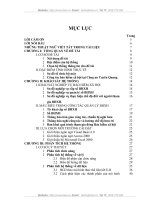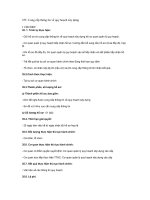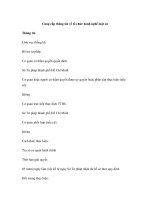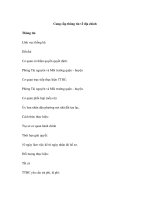Naval architecture term
Bạn đang xem bản rút gọn của tài liệu. Xem và tải ngay bản đầy đủ của tài liệu tại đây (52.94 KB, 6 trang )
NAVAL ARCHITECTURE (SHIP CONSTRUCTION)
Ships terms
1.
2.
3.
4.
5.
6.
7.
8.
Ships structural parts
Various ship configurations. Examples:
Flush deck ship
Three-island ship
Long bridge ship
Shelter deck ship
Ships with raised quarter-deck
Superstructure aft
Ships dimensions and forms ^
1. Base line
2. Bending moment
3. Camber
4. Centreline
5. Dead-weight
6. Depth extreme
7. Depth moulded
8. Draught extreme
9. Draught moulded
10. Displacement
11. Entrance
12. Flare
13. Freeboard
14. Freeboard deck
15. Half-length amidship
16. Length overall
17. Length between perpendiculars
18. Rake
19. Rise of floor
20. Run
21. Sheer
22. Tumblehome
Stresses in ships structure ^
1. Static Stresses
2. Stresses due to water pressure
3. Stresses due to weight
4. Bending
5. Hogging
6. Sagging, shear, thermal effects
7. Forces during dry-docking
8. Dynamic Stresses
9. Bending
10. Hogging
11. Sagging
12. Racking
13. Panting
14. Pounding
15. Thu
Steel profiles and plates used in shipbuilding ^
1. Angles
2. Equal
3. Unequal
4. Bulb angles
5. Bulb plates
6. Channel bar
7. I or H beams
8. Tee bar
9. Flat Bar
10. Round bar
1
11. Half round
12. Tyzack moulding
Aluminium used in shipbuilding ^
1. General uses
2. Aluminium alloys
Structural Fire protection ^
1.
2.
3.
4.
5.
International Regulations (IMO)
Canadian Regulations and Standards
Bulkheads and decks rating
Fire zones
Penetrations
Riveting (Historical reference) ^
1.
2.
3.
4.
5.
Rivet strength (descriptive)
Rivet types
Rivet Heads
Rivet points
Riveting and spacing
Welding and cutting processes ^
1.
2.
3.
4.
5.
6.
7.
8.
Welding
Equipment
Procedures
Electric arc welding
Slag shielded processes
Manual electrode
Gravity welding
Fusarc
9. Submerged arc
10. Stud welding
11. Gas shielded processes
12. Tungsten-Inert Gas (T.I.G.)
13. Metal Inert Gas (M.I.G.)
14. Other welding processes
15. Electro-slag
16. Consumable guide
17. Electro - gas
18. Thermit welding
19. Cutting processes
20. Gas cutting
21. Plasma arc cutting
22. Gouging
23. Lancing
24. Testing welds
25. General
26. Weld faults
27. Non destructive testing
28. Visual
29. Dye penetrant
30. Magnetic particles
31. Radiographic
32. Ulrasonic
33. Weld tests
Keels ^
1.
2.
3.
4.
Bar keels
Flat plate
Duct keel
Bilge keels
Systems of construction ^
2
Transverse system
1. Longitudinal system
2. Combined syatem
Single bottom construction ^
1. Transverse framing
2. Longitudinal framing
Double bottoms ^
1.
2.
3.
4.
5.
6.
7.
Transverse framing
Longitudinal framing
Inner bottom plating
Margin plates and tank side brackets
Precautions against pounding
Cofferdams
Testing
Side structures ^
1.
2.
3.
4.
5.
6.
7.
8.
9.
Frames and framing systems
Types of frames
Welded
Web frames
Deep frames
Frame spacing
Framing in tween decks
Numbering of frames
Portholes and windows
Deck structures ^
1. Beams
2. Functions
3. Sections used
4. Systems
5. Transverse
6. Longitudinal
7. Deep beams
8. Half beams
9. Hatch end beams
10. Brackets
11. Pillaring
12. Functions
13. Ordinary pillars
14. Massed pillaring
15. Longitudinal bulkheads
16. Construction and fitting
17. Deck girders
18. Functions
19. Fitting
20. Construction
21. Hatch side girders
Shell and deck plating ^
1. General
2. Stresses on plating
3. Shell expansion diagrams
4. Identifying plates
5. Special plates
6. Stealer plate
7. Shoe plate
8. Coffin plate
9. Boss plate
10. Oxter plate
3
11. Plating systems
12. Joggled plating, straight frames
13. In and out plating, straight frames
14. Clinker plating, joggled frames
15. Flush welded
16. Plating at sheerstrake
17. Openings
18. Connection of deck stringer to sheerstrake
19. Crack arrestors
20. Shift of butts
21. Tween deck at ships side
22. Openings in plating
23. Deck
24. Shell
25. Lloyds classification of plating
26. Width
27. Thickness
28. Sheathing
29. Hatchways
30. Deck openings
31. Height of coamings
32. Coamings
33. Hatch end beams
34. Half beams
35. Longitudinal at coamings
36. Hatches in oil tankers
37. Bulwarks and freeing ports
38. Scuppers and sluices
Hatch covers ^
1. Single pull hatch covers
2. Hinged hatch covers
3. Direct lift hatch covers
4. Sealing and fastening methods
5. Maintenance of mechanical hatch covers
Bulkheads ^
1. Watertight Bulkheads
2. Uses
3. Number and location
4. Height
5. Fitting
6. Plating
7. Stiffeners
8. Corrugated Types
9. Passages for pipes, cables and ventilation
10. Boundary connections
11. Testing
12. Non-watertight bulkheads
13. Watertight doors
14. Vertical type
15. Horizontal
16. Clip and hinge doors
Deep tanks ^
1.
2.
3.
4.
5.
6.
7.
Purpose
Construction
Ordinary deep tanks
Deep tanks used as oil fuel bunkers
Deep tanks used for carrying oil as a cargo
Use of cofferdams
Testing
Peaks and panting arrangements ^
4
1.
2.
3.
4.
5.
6.
General
Peak tanks
Testing
Fore peak
Construction
Panting Arrangements - Forward of the collision
bulkhead
7. Arrangements aft of the collision bulkhead
8. After peak
9. Construction
10. Panting arrangements
Stems ^
1.
2.
3.
4.
Bar Stem
Plate stem
Composite stems
Bulbous bow
Chain lockers and anchoring arrangements ^
1.
2.
3.
4.
5.
General
Construction
Hawse pipes
Spurling pipes
Mooring and anchoring arrangements
Sterns ^
1.
2.
3.
4.
5.
General
Ordinary sterns - counter or elliptical
Cruiser
Transom
Rudder trunks
Rudders and sternframes ^
1. General
2. Rudders
3. Single plate
4. Double plate
5. Balanced
6. Construction of rudders
7. Gudgeons
8. Pintles
9. Ordinary
10. Locking
11. Bearing
12. Couplings
13. Sternframes
14. Single screw
15. Double screw
16. Transom floor
17. A-Brackets
18. Bossing
Stern Tubes ^
1.
2.
3.
4.
5.
6.
7.
8.
Water lubricated
Oil lubricated
Fitting of stern tubes and shafting
Light method
Laser method
Piano wire
Checking
Strengthening around Stern Tubes
Ducted propellers ^
5
1. General
2. Fixed
3. Active
Engine and boiler rooms ^
1. General arrangements
2. Engine and boiler seating
3. Shaft tunnels
4. Casings
Superstructures and deckhouses ^
1.
2.
3.
4.
5.
6.
7.
8.
9.
Definitions
Forecastles
Poops
Bridges
Long and short bridges
Plating
Bulkhead construction
Deckhouses
Raised quarterdecks
Miscellaneous details ^
1.
2.
3.
4.
Ventilators
Air pipes
Sounding pipes
Overboard discharges
Strengthening for navigation in ice ^
1. Canadian Arctic Pollution Regulations
2. Ice Class notations
Ship types requiring special considerations ^
1.
2.
3.
4.
5.
6.
Icebreakers
Buoy tenders
LPG and LNG
VLCC and double hull tankers
High speed craft
Ro-Ro ferries
Classification societies and vessel regulatory
authorities ^
1. General
2. Lloyds, American Bureau of Shipping and other
classification societies
3. Transport Canada Marine Safety
4. International Maritime Organisation (IMO)
5. Inspection and Surveys
6. Annual
7. Docking
8. Special Surveys
9. Continuous Surveys
10. Damage and Repairs
Shipyard practice ^
1.
2.
3.
4.
5.
6.
Shipyard Layout
Drawing office activities
Plate preparation and machining
Prefabrication and unit construction
Launching
Dry Docking
6









